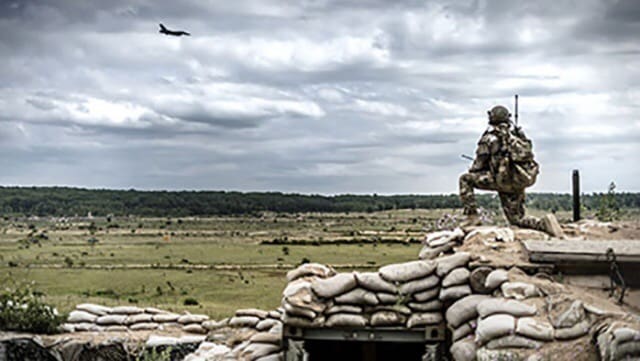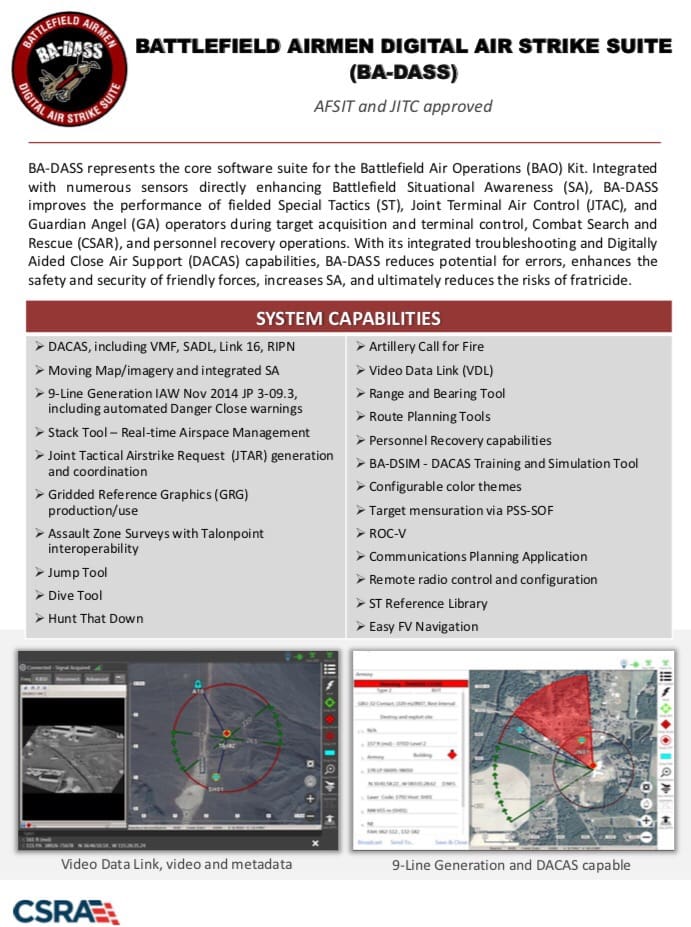Air Combat Command (ACC) recently selected Battlefield Airmen – Digital Air Strike Suite (BA-DASS) as the near term Digitally Aided Close Air Support (DACAS) software solution for Tactical Air Control Party (TACP) warfighters. Following a formal evaluation and comparison of multiple DACAS systems, ACC concluded that BA-DASS was the best fit for the TACP community. ACC stated, “This software selection is to provide immediate force multiplier capability to TACP warfighters.”

Senior Airman Nathan Dupler, 113th Air Support Operations Squadron, Terre Haute, Ind., conducts a close air support training mission with an F-16 Fighting Falcon, July 29, 2015, at Grayling Air Gunnery Range, Grayling, Mich., during Northern Strike 15. NS 15 is an annual training exercise on CGJMTC that assesses joint air-to-ground capability and involves hundreds of military personnel from 20 different states as well as Canada, Latvia, Poland and Australia. (U.S. Air National Guard photo by Master Sgt. Scott Thompson/released)
Download the full pdf here.



Badass…
So, I’m getting confused. What is the difference between the AF ATAK, NSW’s A-PASS and this system called BA-DASS??
I hate to sound like Capt. Obvious, but how does help if each service or sub-SOCOM element has there own CCAS or is that not an issue? Do all three systems communicate the same info to the pilots or is only the display and user input that is different?
Thanks!
Gotta agree with you. If they all behave differently and transmit information differently then it removes the “Joint” from Joint Terminal Attack Controler.
It’s the interface at the TAC level. The data standards are all the same.
Thanks for the clarification.
One other point of performance: In the “what if scenario”, you have a AF CCT embedded w/ a JSOC team, they go down, Army dudes may not understand the CCT system, visa-versa?
Also why don’t all “JTACs” have the same school? The army calls it something different as well. Just curious.
Thanks
Just as we have different service flight schools, there are a few CAS/JTAC schools. I’m a graduate of the “Old School” USAF JFCC-then-Upgrade method of calling CAS. Since the demands of post-9/11, we’ve stood-up different ways due to the demand. In my unit alone we had guys who graduated from JFCC, USMC-TACP course, and SOTACC. The Army calls JTACs the same as everyone else: JTAC. It is a joint service identifier and is detailed in the joint pubs.
If any system goes down it’s not the end of the world. No JTAC in his right mind should be relying on any of these systems to do the job. They all mostly help with correlation on the spot and a some with coordination but most of this stuff will be used for pre-mission planning and not so much when rounds are popping off. Screens will break, batteries will die. A good JTAC can fall back on a GRG, a pen and a radio and they’ll get the job done.
There are different JTAC schools for Army and Navy. The Standards remain the same in each school in order to be certified and the standards to maintain the qual once you have it. We’re all taught from the same doctrine even if we don’t train together. It’s like college, if you went to Harvard and I went to Yale to study the same subject, at the end of our time there we’d Both be certified as douche bag officers.
Like it!! Thanks!
Great analogy!
Anyone know of companies in the Austin, TX area working on DOD tech like this to help the warfighter (big picture, not specific to CAS/JTAC)? I’m looking for a career move.
Any help is appreciated,
-Mike
I’m sure the name had nothing to do with the selection . . . ; )